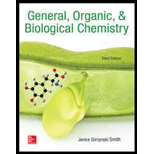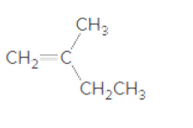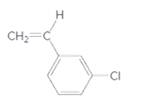
Interpretation:
The structure of polymer formed on polymerizing following compound should be determined:

Concept Introduction:
Based on type of polymers, polymerization reaction can be two types; addition polymerization and condensation polymerization. The addition polymerization occurs between monomer units with unsaturated bonds between carbon atoms. For example; polymerization of
Condensation polymerization occurs with those monomers which have some functional groups like −OH, -COOH, -NH2 etc. These polymerizations occur with elimination of small molecules such as H2O, CO, and CO2 etc.
Interpretation:
The structure of polymer formed on polymerizing following compound should be determined:

Concept Introduction:
Polymers are macromolecules which are composed of a large number of small repeating units. This repeating units are known as monomers and the process of formation of polymers from monomer units is known as polymerization.
Based on type of polymers, polymerization reaction can be two types; addition polymerization and condensation polymerization. The addition polymerization occurs between monomer units with unsaturated bonds between carbon atoms. For example; polymerization of alkene leads to formation of polyalkenes.
Condensation polymerization occurs with those monomers which have some functional groups like −OH, -COOH, -NH2 etc. These polymerizations occur with elimination of small molecules such as H2O, CO, and CO2 etc.
Interpretation:
The structure of polymer formed on polymerizing following compound should be determined:

Concept Introduction:
Polymers are macromolecules which are composed of a large number of small repeating units. This repeating units are known as monomers and the process of formation of polymers from monomer units is known as polymerization.
Based on type of polymers, polymerization reaction can be two types; addition polymerization and condensation polymerization. The addition polymerization occurs between monomer units with unsaturated bonds between carbon atoms. For example; polymerization of alkene leads to formation of polyalkenes.
Condensation polymerization occurs with those monomers which have some functional groups like −OH, -COOH, -NH2 etc. These polymerizations occur with elimination of small molecules such as H2O, CO, and CO2 etc.
Want to see the full answer?
Check out a sample textbook solution
Chapter 13 Solutions
General, Organic, & Biological Chemistry
- What polymer is formed in this reaction, using polymer notation?arrow_forwardWhat polymer is formed when methyl α-methylacrylate [CH 2 C(CH 3)CO2CH 3] is polymerized? This polymer is used in Lucite and Plexiglas, transparent materials that are lighter but more impact resistant than glass.arrow_forwardDrawing the Structure of a Polymer Formed from a Monomer What polymer is formed when CH2=CHCO2H (acrylic acid) is polymerized to form poly(acrylic acid)?arrow_forward
- Poly(trimethylene carbamate) is used in high-quality synthetic leather.Draw the products that would be formed if the polymer were completelyhydrolyzed under acidic or basic conditions.arrow_forwardWhat polymer is formed when CH2=CHCO2H (acrylic acid) is polymerized toform poly(acrylic acid)?arrow_forwardPoly(butylene terephthalate) is a hydrophobic plastic material widely used in automotive ignition systems. What type of polymer is poly(butylene terephthalate)?arrow_forward
 Chemistry: The Molecular ScienceChemistryISBN:9781285199047Author:John W. Moore, Conrad L. StanitskiPublisher:Cengage Learning
Chemistry: The Molecular ScienceChemistryISBN:9781285199047Author:John W. Moore, Conrad L. StanitskiPublisher:Cengage Learning Chemistry: Principles and PracticeChemistryISBN:9780534420123Author:Daniel L. Reger, Scott R. Goode, David W. Ball, Edward MercerPublisher:Cengage Learning
Chemistry: Principles and PracticeChemistryISBN:9780534420123Author:Daniel L. Reger, Scott R. Goode, David W. Ball, Edward MercerPublisher:Cengage Learning Chemistry for Today: General, Organic, and Bioche...ChemistryISBN:9781305960060Author:Spencer L. Seager, Michael R. Slabaugh, Maren S. HansenPublisher:Cengage Learning
Chemistry for Today: General, Organic, and Bioche...ChemistryISBN:9781305960060Author:Spencer L. Seager, Michael R. Slabaugh, Maren S. HansenPublisher:Cengage Learning ChemistryChemistryISBN:9781305957404Author:Steven S. Zumdahl, Susan A. Zumdahl, Donald J. DeCostePublisher:Cengage Learning
ChemistryChemistryISBN:9781305957404Author:Steven S. Zumdahl, Susan A. Zumdahl, Donald J. DeCostePublisher:Cengage Learning Chemistry: An Atoms First ApproachChemistryISBN:9781305079243Author:Steven S. Zumdahl, Susan A. ZumdahlPublisher:Cengage Learning
Chemistry: An Atoms First ApproachChemistryISBN:9781305079243Author:Steven S. Zumdahl, Susan A. ZumdahlPublisher:Cengage Learning





